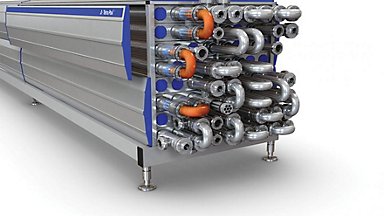Devils and details – the technologies you need for great spreadable cheese
It’s said that the devil is in the detail. This is certainly true in cheese production, where even small differences in processing equipment can have a major impact on your product quality.

Spreadable cheese processing relies primarily on two key technologies: heating and mixing. But the equipment delivering these process steps varies considerably. So what do you need to know when choosing – and what should you look out for?
The first step in the processing line is mixing. Effective mixing is crucial when producing recombined spreadable cheese varieties containing powder ingredients. Lump-free dissolution of all powders is essential, as is good emulsification of added cheese ingredients.
Traditional mixers, which use knives that rotate at high speed, are good at handling 100% cheese ingredients, like the cheese blocks used to produce classic spreadable processed cheese. But they are not optimized for powders.
The Tetra Pak® High Shear Mixer can handle all cheese ingredients and is capable of mixing everything from spreadable processed cheese made from cheese blocks to recipes based on powder recombination. It has specially designed knives at the top of the mixing unit for cutting and grinding cheese blocks, combined with a rotor stator system below for dissolving powders and emulsifying the cheese product.
The mixing unit’s design allows product to be transported down to the rotor stator system. Once the product is inside the mixing unit, a rotating propeller forces it out through tiny holes in the surrounding stator. This high shear effect gives very effective dispersion of powders into liquids and instant emulsification of the cheese product.
Achieve consistent quality, save money
“If you have powders in a knife-type mixer, the stabilisers can clog together and you get fisheyes in the product. But with high shear, you can mix stabilisers such as starches and emulsifiers very efficiently,” says Palle Bach Jensen, Customer Manager Tetra Pak
Not only does this ensure consistent product quality; it also saves money because, in most cases, you use fewer additives such as emulsifying salts and stabilizers.
“The high shear effect saves on expensive ingredients, which cuts your production costs,” Jensen explains.
“It can also go from high shear to low shear in the same process, which is useful if you want to add any particles or herbs. By switching to low shear, you lift the stator and thereby retain the integrity of the particles. Competitor solutions can’t do this.”
Uniquely, the Tetra Pak High Shear Mixer can also heat-treat product to 140°C. For pasteurized spreadable cheese produced in batches, this means you can do everything in the mixer.
“For non-aseptic production, our mixer is the most versatile option,” Jensen says. “It really can handle everything in the same unit. For certain types of spreadable cheese and for batch lines, this is a huge advantage.”
Turn up the heat
Heating is a standard step in spreadable cheese manufacture. First you must pasteurize your cheese base to remove unwanted bacteria. If your spread is destined for ambient distribution, ultra-high temperature processing is also required. UHT treatment removes spores and ensures a long shelf life.
In UHT treatment, heat load is a prime consideration. A heat exchanger that can heat your product to the required temperature in the shortest possible time will give you higher product quality at equivalent shelf life than a model that requires a longer heating time.
Shorter heating means a lower heat load, which is gentler on your product. Gentle treatment better preserves taste, flavour and colour particle integrity, enhancing the way your end-consumers experience your product.
The industry standards for continuous heat treatment of spreadable cheese are a scraped heat exchanger or direct steam injection. A Tetra Pak® Coiled Heat Exchanger can do a similar job to these alternatives – and with a shorter retention time and no further water addition to the product, meaning that a lower heat load is applied.
“The coils inside the unit create a secondary force known as the Dean effect,” explains Kamila Lopes Abelha, Application Sales Manager Tetra Pak.
“This promotes in-tube mixing, which boosts heat transfer efficiency and allows us to heat-treat product for 50% less time than the current industrial standard.”
There are other advantages. A coiled tube design allows you to process high viscous spreads in large capacities. By also enabling high velocity, the coils reduce product mixing zones. This minimizes product losses, cuts cleaning costs and saves you money.
“The Tetra Pak Coiled Heat Exchanger is the outstanding choice for spreadable cheese processing,” says Abelha, noting that Tetra Pak is the only manufacturer currently offering a coiled heat exchanger designed to heat-treat spreadable cheese.
Tetra Pak® Coiled Heat Exchanger
A coiled tubular heat exchanger designed to provide efficient heating and cooling of low to high viscous and smooth to particulate products.
Find out more about how the Tetra Pak® Coiled Heat Exchanger can help you maximize the versatility and efficiency of your operations.





